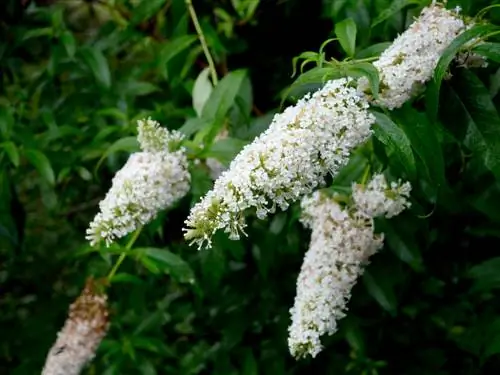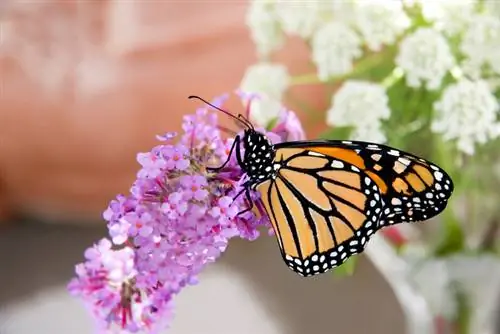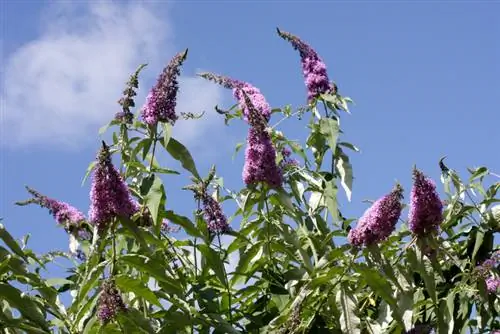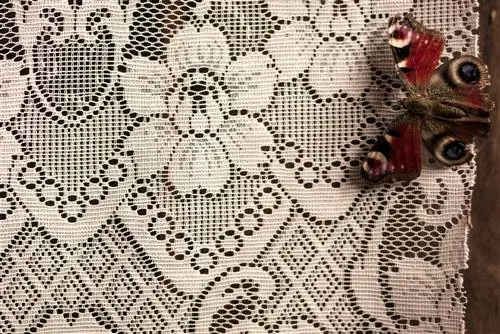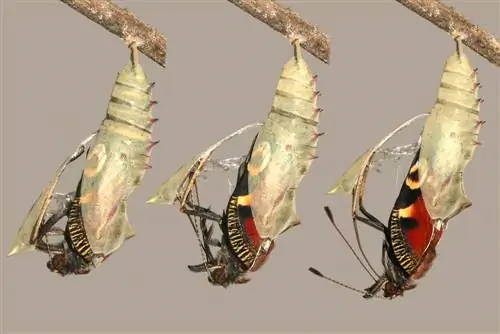- Author admin [email protected].
- Public 2023-12-25 17:45.
- Last modified 2025-01-23 11:19.
The butterfly lilac, known botanically as Buddleja, has its beautiful German name for a reason: the shrub, which usually blooms wonderfully in blue, purple or pink tones, is a magnet for numerous butterflies that are attracted by the sweet nectar. Its abundance of flowers is also the reason why the tree, sometimes known as buddleia, is often planted in the garden. Despite an undeniable visual similarity, Buddleja is not related to the common lilac (bot. Syringa), which is also widespread.
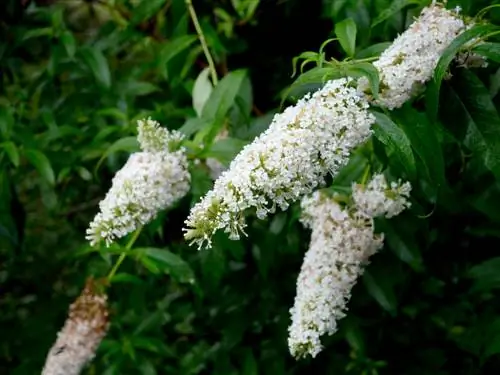
Origin and distribution
The butterfly lilac belongs to the figwort family (Scrophlariacae) and includes around 100 different species. These are widespread in the tropical and subtropical areas of the two American continents as well as Asia and Africa, where they occur primarily in dry, warm and sunny locations. Not all species are used as ornamental plants, especially since the majority of buddleias in this country are not hardy at all. By the way, despite the similarity, the Buddleja species are not related to the common lilac. Botanically speaking, this belongs to the olive tree family (Oleaceae).
Usage
The very robust and sufficiently hardy species Buddleja davidii, which also has the greatest variety of all butterfly lilacs, is particularly popular in the home garden. In addition, the alternating-leaved or Chinese butterfly lilac (Buddleja alternifolia) is also used in borders and in the front garden, whereas the distinctive yellow buddleia (Buddleja x weyeriana) is not frost-hardy and is therefore only allowed outdoors in regions with mild winters. However, all of the butterfly lilacs mentioned are ideal for growing in pots, as long as the variety is not too vigorous.
The butterfly lilac looks good in colorful perennial borders, in a bed with colorful summer flowers, along dry embankments and as a solitary plant in the front garden. Strong-growing varieties with growth heights of up to three meters and growth widths of up to two meters can also be used wonderfully for hedge planting and for delimiting properties and garden spaces.
Plant the shrub together with annual flowers, perennials such as sedum or asters, bulbous flowers or herbs such as sage, lavender or thyme. It is not only important that the colors harmonize when putting together the plants for the border, but that the different species have the same needs in terms of location and care.
Appearance and growth
Buddleja davidii in particular is very suitable for the Central European climate with its sometimes cold and harsh winters. The species also scores points with numerous cultivated forms with different heights and flower colors. Butterfly lilacs usually grow funnel-shaped and wide upright up to three meters high, although some varieties have a rather stocky habit and only grow up to one and a half meters high. The panicle-like flowers are located at the ends of the side shoots, which often bend due to their weight.
The shoots of Buddleja davidii often freeze back in cold winters, but this is usually not a problem. If the root system remains undamaged, the shrub will sprout again in spring and, due to its very rapid growth, will quickly reach the height it reached last year. The species is wintergreen, i.e. H. The green-gray leaves usually remain on the branches until the first frost and only then die off.
Flowers and flowering time
Most species and varieties of butterfly lilac only show their lush flowers from July onwards, but then - at least with appropriate care - well into autumn. The long flower spikes are so heavy that the branches bend under their weight. They also smell more or less strong depending on the variety, and there is a very large selection of flower colors. The panicles bloom in different shades of white, pink, red or purple, only yellow colors are reserved for the non-hardy yellow butterfly lilac.
In order to enjoy the flowering period for as long as possible, you should cut off spent shoots as soon as possible. This also prevents the development of capsule fruits, which often contain numerous seeds. If you're not careful, these tend to self-seed and you have to remove young butterfly lilacs from the entire garden the following year.
Toxicity
Even though a wide variety of butterflies love to feast on the sweet nectar of the butterfly lilac, unfortunately all parts of the plant are poisonous to people and pets. The leaves and seeds in particular contain toxic substances, including saponins and glycosides such as catapol and aucubin. Therefore, never feed the clippings to your pets, including cattle or horses, and make sure that small children do not snack on the leaves or flowers. If symptoms of poisoning occur, such as headaches, nausea, cramps, diarrhea and/or vomiting (it doesn't have to all happen at once!), please consult a doctor or veterinarian immediately.
He althy plant parts can, however, be composted safely.
Which location is suitable?
Since the butterfly lilac comes from warm and sunny countries, it also feels particularly comfortable in the same location in the garden. The buddleia is very comfortable in a hot location with full sun during the midday hours, which is why you can plant it on a bright, south-facing wall. Place the shrub in a full sun and protected place, although if necessary a location in light partial shade is sufficient. However, it is important that the Buddleja receives a few hours of direct sun each morning and evening. But if it is too shady, the butterfly lilac stops growing and does not produce any flowers.read more
Substrate / Soil
The ideal soil for butterfly lilac is well-drained, loose and only moderately nutrient-rich. The shrub likes to grow in a lean and gravelly substrate. However, the plant does not tolerate loamy, heavy or wet soils, which is why when planting you should improve the soil by adding compost and gravel/sand if necessary and also ensure drainage. In this way, waterlogging cannot occur in the first place.
pot culture
Frost-sensitive species of butterfly lilac such as Buddleja globosa or Buddleja x weyeriana should, if possible, be cultivated in large containers and not planted out in the garden. Small-growing varieties of Buddleja davidii and other hardy butterfly lilac species can also be cultivated very well in planters, as long as the container chosen is large enough and offers plenty of space for the roots.
The so-called dwarf butterfly lilacs such as 'Summer Lounge' or 'Purple Emperor' are particularly suitable for this. They reach heights of up to around 150 centimeters and therefore also fit on cramped balconies. However, the following applies to all butterfly lilacs: Choose a large, wide and deep planter made of ceramic or clay. This offers the roots plenty of space and at the same time prevents the interior from heating up due to possible evaporation. Although the butterfly lilac likes sun and warmth, it thrives best when the roots are kept cool.
Fill the potting soil mixed with gravel and expanded clay into the plant, but of course you shouldn't forget about the pot's drainage: the drainage hole at the bottom of the pot is mandatory so that excess irrigation water can drain away. The butterfly lilac needs to be fertilized and watered regularly so that it neither dries out nor remains permanently wet with its roots. Between April and August you also provide the shrub with a liquid container plant fertilizer, but you only need to use it in small doses. The nutrient requirements of the butterfly lilac are only low. During the winter months, only little watering is carried out, little fertilization is applied and the plant is, if possible, overwintered in a cool and bright room, frost-free.
Planting butterfly lilacs correctly
Butterfly lilac is often grown and offered in containers. When planting these specimens, you should make sure not to plant them deeper in the garden than they were previously in the pot. If necessary, mark the relevant spot with a pen.
Continue planting Buddleja as follows:
- Lift the plant out of the container, shake off the soil.
- Now place it with the root ball in a bucket filled with water.
- Let them soak up the moisture.
- In the meantime, dig a planting hole.
- This should be twice as deep and wide as the root ball.
- Place a drainage layer approximately five centimeters thick on the bottom of the planting hole, e.g. B. with coarse gravel.
- Mix the excavated material with plenty of compost and possibly gravel/sand.
- Plant the butterfly lilac. Tread the soil carefully.
- Wilt the root area well.
To prevent premature drying out due to evaporation, especially in hot and dry times, you can cover the area of the roots with bark mulch or another material.read more
What is the best time to plant?
All types and varieties of butterfly lilac should only be planted in the garden after the Ice Saints in May. It is ideal when the ground is already a little warmer and there are no more night frosts. Now the shrub can grow safely until the first frost.
The correct planting distance
The varieties of the species Buddleja davidii in particular can take up a lot of space with a height of around three meters and a width of up to two meters - especially since the bushes also grow very quickly and a planting distance that is too narrow can quickly become a problem can be. Solitary plants should be planted at a distance of at least 150 centimeters, while for hedges and groups between 80 and 100 centimeters is sufficient, depending on the variety. The dwarf versions require significantly less space for themselves.
Underplants
Since the butterfly lilac often remains bare in the lower area, you can plant it well with annual summer flowers, bulbous flowers or low-growing perennials.
How do I transplant correctly?
In May or June, or even in early autumn if necessary, the butterfly lilac can usually be moved to a new location without any problems. You should only avoid transplanting in the middle of summer, as the inevitable loss of roots can quickly cause the shrub to suffer from a lack of water. By the way, this is also the reason why plants that are to be moved always have to be cut back. And this is how it works:
- Cut the butterfly lilac back by about a third.
- Tie the shoots together in the upper area with a ribbon or something similar.
- However, do not crush or injure the branches.
- Dig a trench around the shrub with a sharp spade.
- Cut longer roots.
- Loose the root ball using a digging fork.
- Carefully lift out the entire plant.
- Replace them in a new location.
- Water it plenty to help it grow.
- Increased watering is also important in the weeks after moving.
By the way, you should also mix the excavated material from the planting hole with plenty of compost.read more
Watering butterfly lilacs
Even if freshly planted butterfly lilac needs to be watered well every now and then so that it grows better and does not come under drought stress, specimens that are already established in their location only very rarely need water from the garden hose or watering can. You can only water it if it is warm and dry for a longer period of time and / or the shrub shows corresponding signs. Buddleja kept in pots, on the other hand, rely on a regular supply of the precious water because they are unable to do so themselves. However, be sure to avoid waterlogging, as this inevitably leads to root rot.
Since the butterfly lilac is very lime-tolerant, you can safely water it with water from the tap.
Fertilize butterfly lilacs properly
The butterfly lilac is quite undemanding not only when it comes to water, but also when it comes to nutrient supply. When planting and always after pruning, provide planted shrubs with plenty of compost and a handful of horn shavings to stimulate subsequent new growth. If the Buddleja doesn't really want to get into the mood to bloom, a nutrient deficiency may be the cause. Eliminate this with a liquid universal fertilizer or with more frequent supply of compost or manure. Only butterfly lilacs kept in planters need to be given a liquid fertilizer for potted plants together with the irrigation water every two weeks.read more
Cut butterfly lilac correctly
Any cutting measures for butterfly lilac always depend on the respective species and variety. Buddleja davidii, for example, only produces flowers on the new shoots and should therefore be cut back drastically in spring: the gardener calls this “putting it on the stick”. Cut all parts of the plant to a height of 20 to 30 centimeters above the ground, although this measure will probably be necessary after most winters anyway: the species often freezes back in frosty temperatures. If possible, do this pruning in March, but no later than April.
Other types of butterfly lilac, however, such as the Chinese buddleia Buddleja alternifolia, must not be pruned so severely. After flowering, you simply thin out these species by cutting off branches that are too dense and have dried out. However, be careful not to cut off any new shoots, as this is where the species will bloom next year.
No matter what type of butterfly lilac it is, you should always cut back dead shoots. In this way, the shrub does not put its energy into producing fruits and seeds, but instead produces new flowers.read more
Propagate butterfly lilacs
If you particularly like a particular butterfly lilac, you should always propagate it from cuttings. Only in this way are the offspring actually pure and have the same characteristics as the mother plant - after all, in principle it is a genetically identical clone. You can achieve the same effect if you plant cutters instead of cuttings or take cuttings from the cuttings. The vegetative method of propagation works easily for butterfly lilac according to this scheme:
- The best time to cut cuttings is June and July.
- Choose young, semi-woody branches without developed flowers for this purpose.
- Completely woody branches are not suitable for cuttings, but are suitable as cuttings.
- Cuttings ideally have a length of ten to 15 centimeters.
- Remove all but the top two or three leaves.
- Cut them in half so that not too much water evaporates through the leaves.
- Place the cuttings separately in pots with lean growing substrate.
- Always keep it slightly moist, but it must not be dripping wet.
- Put a translucent covering over it to improvise a mini greenhouse.
- Cling film or a cut-off PET bottle are suitable for this purpose.
- Now place the pot in a bright and warm place without direct sunlight.
- Don’t forget: ventilate daily!
You can finally remove the protective cover when the cuttings develop the first new shoots. However, keep the young butterfly lilac frost-free for the first winter, but keep it cool and bright and only plant it out next spring.
Do you like surprises? Then sow Buddleja seeds that you have collected or purchased yourself, sow them and see if a new variety comes out of it.read more
Diseases and pests
The butterfly lilac is a very robust plant that is rarely attacked by pathogens or pests. If problems do arise, it is usually due to care errors or the plant does not feel comfortable in its location. If Buddleja develops yellow leaves, this is usually an indication of excessive watering or even waterlogging. This quickly becomes apparent through wilting and drying up of first individual and later several shoots.
Tip
Even the basically winter-hardy variants of the Buddleja davidii species still need light winter protection as young plants, for example in the form of a cover of leaves or brushwood on the root disk. However, if the above-ground parts of the plant have frozen back, simply cut them back vigorously in the spring; the plant will sprout again very quickly.
Species and varieties
The greatest variety of varieties can be found in the popular Buddleja species B. davidii, whose numerous variants look very different in terms of growth and color. These cultivated forms, for example, are pretty for the home garden:
- ‘Adonis Blue’: dark blue, very beautiful flower color
- ‘African Queen’: violet-blue flower spikes, bright color
- ‘Black Knight’: dark purple flower spikes, very dark color
- 'Cardinal': bright dark pink flower spikes
- ‘Empire Blue’ blue-violet, light flower color
- 'Pink Delight': bright light pink flower spikes
- 'Purple Emperor': purple-red, rather dark flower spikes
- ‘White Bouquet’: bright pure white flower color
The only yellow-flowering butterfly lilac is the 'Sungold' variety of yellow buddleia (Buddleja x weyeriana).

